2018 KIA SEDONA turn signal
[x] Cancel search: turn signalPage 76 of 586

Safety features of your vehicle
60
3
How does the air bag system
operate
Air bags are activated (able to
inflate if necessary) only when the
ignition switch is turned to the ON
or START position.
The appropriate air bags inflate instantly in the event of a serious
frontal collision or side collision in
order to help protect the occupants
from serious physical injury.
There is no single speed at which the air bags will inflate.
Generally, air bags are designed to
inflate based upon the severity of a
collision and its direction. These
two factors determine whether the
sensors produce an electronic
deployment/ inflation signal.
Air bag deployment depends on a number of factors including vehicle
speed, angles of impact and the
density and stiffness of the vehi-
cles or objects which your vehicle
hits in the collision. The determin-
ing factors are not limited to those
mentioned above. The front air bags will completely
inflate and deflate in an instant.
It is virtually impossible for you to
see the air bags inflate during an
accident.
It is much more likely that you will
simply see the deflated air bags
hanging out of their storage com-
partments after the collision.
In addition to inflating in serious side collisions, side and/or curtain
air bags will inflate if the sensing
system detects a rollover.
When a rollover is detected, side and/or curtain air bags will remain
inflated longer to help provide pro-
tection from ejection, especially
when used in conjunction with the
seat belts. In order to help provide protection,
the air bags must inflate rapidly.
The speed of the air bag inflation is
a consequence of extremely short
time in which to inflate the air bag
between the occupant and the
vehicle structures before the occu-
pant impacts those structures. This
speed of inflation reduces the risk
of serious or life-threatening
injuries and is thus a necessary
part of the air bag design.
However, air bag inflation can also
cause injuries which can include
facial abrasions, bruises and bro-
ken bones because the inflation
speed also causes the air bags to
expand with a great deal of force.
There are even circumstances under which contact with the
steering wheel or passenger air
bag can cause fatal injuries,
especially if the occupant is
positioned excessively close to
the steering wheel or passenger
air bag.
Page 105 of 586
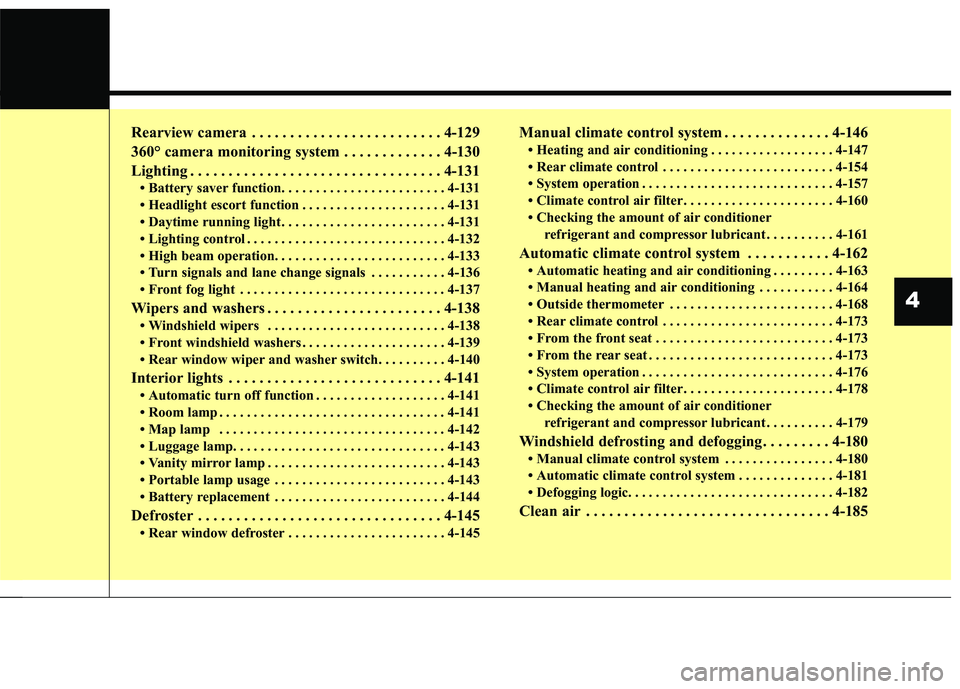
Rearview camera . . . . . . . . . . . . . . . . . . . . . . . . . 4-129
360° camera monitoring system . . . . . . . . . . . . . 4-130
Lighting . . . . . . . . . . . . . . . . . . . . . . . . . . . . . . . . . 4-131
• Battery saver function. . . . . . . . . . . . . . . . . . . . . . . . 4-131
• Headlight escort function . . . . . . . . . . . . . . . . . . . . . 4-131
• Daytime running light . . . . . . . . . . . . . . . . . . . . . . . . 4-131
• Lighting control . . . . . . . . . . . . . . . . . . . . . . . . . . . . . 4-132
• High beam operation. . . . . . . . . . . . . . . . . . . . . . . . . 4-133
• Turn signals and lane change signals . . . . . . . . . . . 4-136
• Front fog light . . . . . . . . . . . . . . . . . . . . . . . . . . . . . . 4-137
Wipers and washers . . . . . . . . . . . . . . . . . . . . . . . 4-138
• Windshield wipers . . . . . . . . . . . . . . . . . . . . . . . . . . 4-138
• Front windshield washers . . . . . . . . . . . . . . . . . . . . . 4-139
• Rear window wiper and washer switch. . . . . . . . . . 4-140
Interior lights . . . . . . . . . . . . . . . . . . . . . . . . . . . . 4-141
• Automatic turn off function . . . . . . . . . . . . . . . . . . . 4-141
• Room lamp . . . . . . . . . . . . . . . . . . . . . . . . . . . . . . . . . 4-141
• Map lamp . . . . . . . . . . . . . . . . . . . . . . . . . . . . . . . . . 4-142
• Luggage lamp. . . . . . . . . . . . . . . . . . . . . . . . . . . . . . . 4-143
• Vanity mirror lamp . . . . . . . . . . . . . . . . . . . . . . . . . . 4-143
• Portable lamp usage . . . . . . . . . . . . . . . . . . . . . . . . . 4-143
• Battery replacement . . . . . . . . . . . . . . . . . . . . . . . . . 4-144
Defroster . . . . . . . . . . . . . . . . . . . . . . . . . . . . . . . . 4-145
• Rear window defroster . . . . . . . . . . . . . . . . . . . . . . . 4-145
Manual climate control system . . . . . . . . . . . . . . 4-146
• Heating and air conditioning . . . . . . . . . . . . . . . . . . 4-147
• Rear climate control . . . . . . . . . . . . . . . . . . . . . . . . . 4-154
• System operation . . . . . . . . . . . . . . . . . . . . . . . . . . . . 4-157
• Climate control air filter . . . . . . . . . . . . . . . . . . . . . . 4-160
• Checking the amount of air conditionerrefrigerant and compressor lubricant . . . . . . . . . . 4-161
Automatic climate control system . . . . . . . . . . . 4-162
• Automatic heating and air conditioning . . . . . . . . . 4-163
• Manual heating and air conditioning . . . . . . . . . . . 4-164
• Outside thermometer . . . . . . . . . . . . . . . . . . . . . . . . 4-168
• Rear climate control . . . . . . . . . . . . . . . . . . . . . . . . . 4-173
• From the front seat . . . . . . . . . . . . . . . . . . . . . . . . . . 4-173
• From the rear seat . . . . . . . . . . . . . . . . . . . . . . . . . . . 4-173
• System operation . . . . . . . . . . . . . . . . . . . . . . . . . . . . 4-176
• Climate control air filter . . . . . . . . . . . . . . . . . . . . . . 4-178
• Checking the amount of air conditionerrefrigerant and compressor lubricant . . . . . . . . . . 4-179
Windshield defrosting and defogging . . . . . . . . . 4-180
• Manual climate control system . . . . . . . . . . . . . . . . 4-180
• Automatic climate control system . . . . . . . . . . . . . . 4-181
• Defogging logic. . . . . . . . . . . . . . . . . . . . . . . . . . . . . . 4-182
Clean air . . . . . . . . . . . . . . . . . . . . . . . . . . . . . . . . 4-185
4
Page 113 of 586
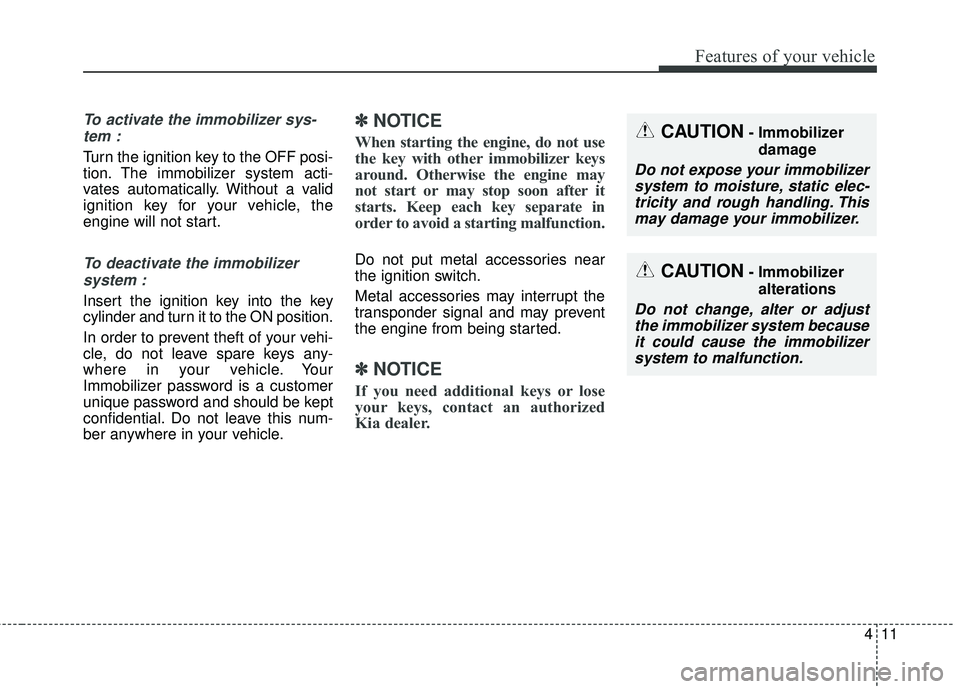
411
Features of your vehicle
To activate the immobilizer sys-tem :
Turn the ignition key to the OFF posi-
tion. The immobilizer system acti-
vates automatically. Without a valid
ignition key for your vehicle, the
engine will not start.
To deactivate the immobilizersystem :
Insert the ignition key into the key
cylinder and turn it to the ON position.
In order to prevent theft of your vehi-
cle, do not leave spare keys any-
where in your vehicle. Your
Immobilizer password is a customer
unique password and should be kept
confidential. Do not leave this num-
ber anywhere in your vehicle.
✽ ✽ NOTICE
When starting the engine, do not use
the key with other immobilizer keys
around. Otherwise the engine may
not start or may stop soon after it
starts. Keep each key separate in
order to avoid a starting malfunction.
Do not put metal accessories near
the ignition switch.
Metal accessories may interrupt the
transponder signal and may prevent
the engine from being started.
✽ ✽NOTICE
If you need additional keys or lose
your keys, contact an authorized
Kia dealer.
CAUTION- Immobilizer
damage
Do not expose your immobilizersystem to moisture, static elec-tricity and rough handling. Thismay damage your immobilizer.
CAUTION- Immobilizer
alterations
Do not change, alter or adjustthe immobilizer system becauseit could cause the immobilizersystem to malfunction.
Page 176 of 586
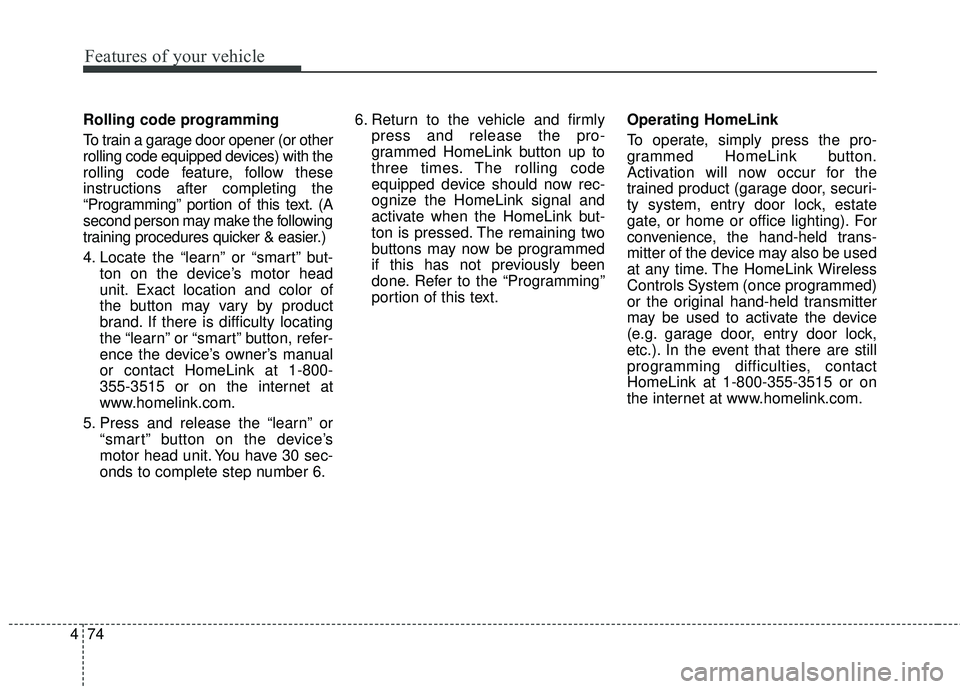
Features of your vehicle
74
4
Rolling code programming
To train a garage door opener (or other
rolling code equipped devices) with the
rolling code feature, follow these
instructions after completing the
“Programming” portion of this text. (A
second person may make the following
training procedures quicker & easier.)
4. Locate the “learn” or “smart” but-
ton on the device’s motor head
unit. Exact location and color of
the button may vary by product
brand. If there is difficulty locating
the “learn” or “smart” button, refer-
ence the device’s owner’s manual
or contact HomeLink at 1-800-
355-3515 or on the internet at
www.homelink.com.
5. Press and release the “learn” or “smart” button on the device’s
motor head unit. You have 30 sec-
onds to complete step number 6. 6. Return to the vehicle and firmly
press and release the pro-
grammed HomeLink button up to
three times. The rolling code
equipped device should now rec-
ognize the HomeLink signal and
activate when the HomeLink but-
ton is pressed. The remaining two
buttons may now be programmed
if this has not previously been
done. Refer to the “Programming”
portion of this text. Operating HomeLink
To operate, simply press the pro-
grammed HomeLink button.
Activation will now occur for the
trained product (garage door, securi-
ty system, entry door lock, estate
gate, or home or office lighting). For
convenience, the hand-held trans-
mitter of the device may also be used
at any time. The HomeLink Wireless
Controls System (once programmed)
or the original hand-held transmitter
may be used to activate the device
(e.g. garage door, entry door lock,
etc.). In the event that there are still
programming difficulties, contact
HomeLink at 1-800-355-3515 or on
the internet at www.homelink.com.
Page 196 of 586

Features of your vehicle
94
4
Lights
One touch turn signal
If this item is checked, the lane
change signals will blink 3, 5 or 7
times when the turn signal lever is
moved slightly.
Head Lamp Delay (if equipped)
If this item is checked, the headlamp
delay function will be activated.
Welcome Light (if equipped)
If this item is checked, the welcome
light function of the pocket lamp will
be activated.
Sound
Park assist system vol. (if equipped)
Adjust the Park Assist System vol-
ume. (Level 1~3).
Blind spot detection Sound (if equipped)
If this item is checked, the blind spot
detection sound function will be acti-
vated.
Welcome sound (if equipped)
If this item is checked, the welcome
sound function will be activated.
Seat / Steering
Seat easy access (if equipped)
If this item is checked, the driver’s
seat will automatically move forward
or rearward for the driver to enter or
exit the vehicle comfortably.
Steering Position
If this item is checked, the warning
function regarding the steering wheel
alignment will be activated.
Page 220 of 586
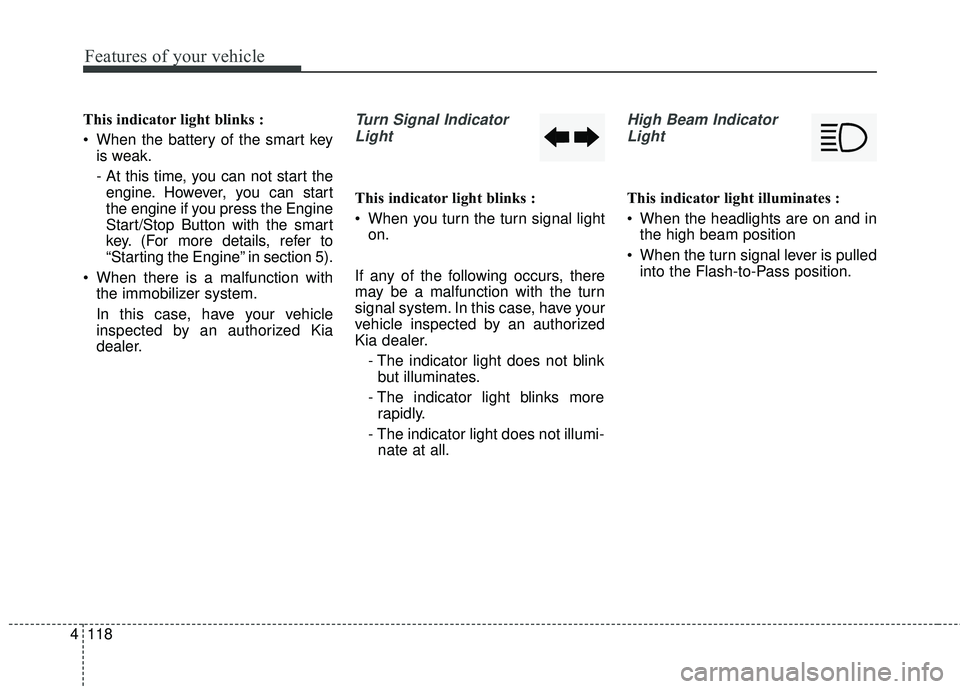
Features of your vehicle
118
4
This indicator light blinks :
When the battery of the smart key
is weak.
- At this time, you can not start theengine. However, you can start
the engine if you press the Engine
Start/Stop Button with the smart
key. (For more details, refer to
“Starting the Engine” in section 5).
When there is a malfunction with the immobilizer system.
In this case, have your vehicle
inspected by an authorized Kia
dealer.Turn Signal Indicator
Light
This indicator light blinks :
When you turn the turn signal light on.
If any of the following occurs, there
may be a malfunction with the turn
signal system. In this case, have your
vehicle inspected by an authorized
Kia dealer. - The indicator light does not blinkbut illuminates.
- The indicator light blinks more rapidly.
- The indicator light does not illumi- nate at all.
High Beam Indicator
Light
This indicator light illuminates :
When the headlights are on and in the high beam position
When the turn signal lever is pulled into the Flash-to-Pass position.
Page 238 of 586
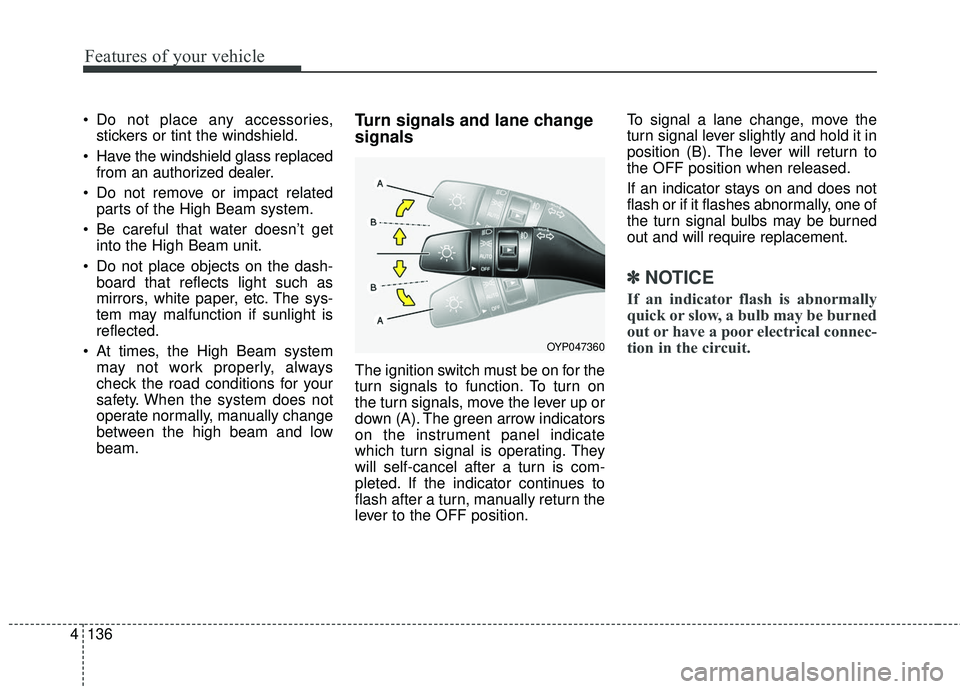
Features of your vehicle
136
4
Do not place any accessories,
stickers or tint the windshield.
Have the windshield glass replaced from an authorized dealer.
Do not remove or impact related parts of the High Beam system.
Be careful that water doesn’t get into the High Beam unit.
Do not place objects on the dash- board that reflects light such as
mirrors, white paper, etc. The sys-
tem may malfunction if sunlight is
reflected.
At times, the High Beam system may not work properly, always
check the road conditions for your
safety. When the system does not
operate normally, manually change
between the high beam and low
beam.Turn signals and lane change
signals
The ignition switch must be on for the
turn signals to function. To turn on
the turn signals, move the lever up or
down (A). The green arrow indicators
on the instrument panel indicate
which turn signal is operating. They
will self-cancel after a turn is com-
pleted. If the indicator continues to
flash after a turn, manually return the
lever to the OFF position. To signal a lane change, move the
turn signal lever slightly and hold it in
position (B). The lever will return to
the OFF position when released.
If an indicator stays on and does not
flash or if it flashes abnormally, one of
the turn signal bulbs may be burned
out and will require replacement.
✽ ✽
NOTICE
If an indicator flash is abnormally
quick or slow, a bulb may be burned
out or have a poor electrical connec-
tion in the circuit.
OYP047360
Page 385 of 586

541
Driving your vehicle
Limitations of the System
The Autonomous Emergency Braking
(AEB) system is designed to monitor
the vehicle ahead or a pedestrian in
the roadway through radar signals and
camera recognition to warn the driver
that a collision is imminent, and if nec-
essary, apply emergency braking.
In certain situations, the radar sen-
sor or the camera may not be able to
detect the vehicle or pedestrian
ahead. In these cases, the AEB sys-
tem may not operate normally. The
driver must pay careful attention in
the following situations where the
AEB operation may be limited.
Detecting vehicles
The sensor may be limited when:
- The radar sensor or camera isblocked with a foreign object or
debris.
- Inclement weather such as heavy rain or snow obscures the field of
view of the radar sensor or cam-
era.
- There is interference by electro- magnetic waves.
- There is severe irregular reflection from the radar sensor.
- The vehicle in front is too small to be detected by the camera recog-
nition system (for example a motor-
cycle or a bicycle, etc.).
- The vehicle in front is an oversize vehicle or trailer that is too big to
be detected by the camera recog-
nition system (for example a tractor
trailer, etc.).
- The driver's field of view is not well illuminated (either too dark or too
much reflection or too much back-
light that obscures the field of
view). - The vehicle in front does not have
their rear lights properly turned
ON.
- The outside brightness changes suddenly, for example when enter-
ing or exiting a tunnel.
- The vehicle in front is driving errat- ically.
- The vehicle drives through a con- struction area, on an unpaved
road, or above metal materials,
such as a railway.
- The vehicle drives inside a build- ing, such as a basement parking
lot.